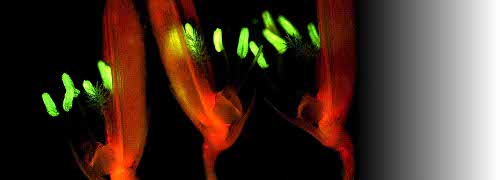In a complex system like a rainforest, the canopy is arranged in horizontal layers, the distribution of leaf area with height being associated with the development in space and time of the diversity of species. However, even in monocultures it is convenient to consider the canopy as being horizontally uniform and the level of radiation constant in any layer. Even here, attenuation of light through the canopy is complicated by changing availability, quality and direction of incident light and it is necessary to make some simplifying assumptions when calculating the proportion of light that is intercepted.
The Beer–Lambert Law, which describes absorption of light by plant pigments in solution, provides a simple approach which has been applied widely to a range of canopies. This function demonstrates that the absorption of light will be more or less decline exponentially with increasing intercepting area down through the canopy. Absorption of sunlight by photosynthesis occurs within a well-defined spectral band (400–700 nm) and matches a peak in energy distribution across the wavelength spectrum of sunlight transmitted to the earth’s surface through our atmospheric window (as shown in Figure 12.1 at the start of the chapter).
Sunlight in this waveband can be represented as either a quantum flux or a radiant energy flux. Quantum flux, or more explicitly, photosynthetic photon flux density (PPFD, PAR), is simplified here to ‘photon irradiance’ (\(Q\)) and has units of µmol quanta m–2 s–1 (‘µmol quanta’ rather than ‘µmol photons’ because quantum energy derived from photons drives photosynthesis). For the sake of making a clear distinction, radiant energy flux is simplified to ‘irradiance’. In the present example, irradiance coincides with photosynthetically active radiation (PAR) and is expressed as joules (J) per square metre per unit time. Depending on the application, time can span seconds, days or years, and is then coupled with either joules, megajoules (MJ) or gigajoules (GJ).
On clear days, PAR represents about half of the total shortwave (solar) radiation or radiant energy flux \(I\) (expressed as J m–2 s–1) incident on a canopy, and is totally responsible for photosynthesis. If changes in the spectral distribution of energy as it passes through the canopy are ignored, \(I\) and PPFD can be used interchangeably in the analysis below. In practice, PPFD is attenuated more rapidly than \(I\) (that is, there is a proportionally larger change in PAR than total solar radiation (\(I\)) in moving from top to bottom of the canopy) because leaves are relatively transparent to the near-infrared part of the solar beam.
Application of the Beer–Lambert Law shows that at any level of cumulative area \(F\) within the canopy, the rate of change of photon irradiance, \(Q\), within the canopy is given by:
\[ \mathrm{d} Q / \mathrm{d} F = -kQ_F \tag{12.2} \]
where \(k\) is the extinction or foliar absorption coefficient, a dimensionless parameter. \(k\) measures the fraction of incident photons absorbed by a unit of leaf area or conversely the fraction of leaf area projected onto the horizontal from the direction of the incident beam. For many species, foliage in the vertical plane is distributed approximately symmetrically about the midpoint of the canopy and most absorption of light will occur in the middle of the canopy. After integration, \(Q_F\) at any level \(F\) is given by:
\[ Q_F = Q_0 e^{–kF} \tag{12.3} \]
where \(Q_0\) is the PAR incident at the top of the canopy. At the base of the canopy, \(F\) is equal to the leaf area index (LAI), a dimensionless number which expresses total projected leaf area of the canopy as a ratio of the ground area over which it is displayed. Thus the level of interceptance is an exponential function of the product \(kF\). If a value of 0.5 is assigned to \(k\), then 95% light interception occurs at \(kF = 3\) which is equivalent to an LAI of 6 m2 leaf area m–2 ground area. Maximum values of LAI vary with species, site, stress and season.
In practice, \(k\) is not a constant value for any canopy and varies with solar elevation, the ratio of direct to diffuse beam irradiance and any changes in canopy structure or leaf inclination and orientation which occur seasonally or in response to the movement of leaves (e.g. heliotropism). For the majority of canopies, \(k\) varies from 0.3 to 1.3. Canopies with erectophile leaves (e.g. grasses) and high leaf angles to the horizontal or with a clumped distribution have a lower \(k\) and intercept less light per unit of foliage compared to canopies with planophile leaves with a higher \(k\) (e.g. clovers) and low leaf angles or a regular distribution. The cumulative leaf area required to intercept 95% of the radiation incident at the top of the canopy will be greater for canopies dominated by erectophile leaves or having a clumped distribution.
In many species and plant communities, leaf inclination may change from erectophile at the top of the canopy to planophile at the bottom. This allows more even distribution and interception of light and reduces the proportion of leaves which is exposed at the top of a canopy to levels of light which are saturating for photosynthesis and, conversely, reduces the proportion of leaves at the bottom of a canopy which is exposed to levels below the light-compensation point for photosynthesis. For a canopy with leaves distributed randomly with respect to orientation and inclination, \(k\) is approximately 0.5 (Monteith and Unsworth 1990) and this value is commonly assigned to \(k\) in the literature.
